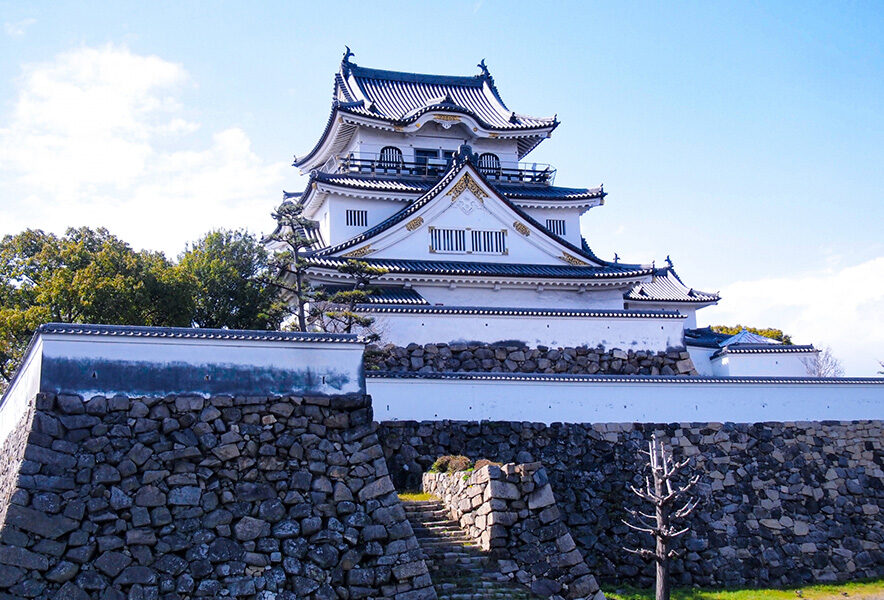- What kind of castle is “Kishiwada Castle”? Involved in many battles during the Warring States Period
- Okabe Nobukatsu and “Kishiwada Castle,” which was responsible for the surveillance of the Kishu Tokugawa family, one of the three Tokugawa families.
- The garden is designated as a place of scenic beauty! Modeled after the “Eight Camps Law”.
- Access to Kishiwada Castle
- Parking around Kishiwada Castle
- Kishiwada Castle Official Website
- Recommended around Kishiwada Castle
What kind of castle is “Kishiwada Castle”? Involved in many battles during the Warring States Period
Kishiwada Castle” was a flat castle (also known as “Chikiri Castle”) located in Kishijo-cho, Kishiwada City, Osaka Prefecture.
The castle is now maintained as Chikiri Park, and the castle tower, turrets, and gates in the park were reconstructed.
The date of construction of the castle is not clear, but it is believed to have been during the Oei period (1394-1428) in the middle of the Muromachi period. In the early 1500s during the Warring States period, the castle became the residence of the Hosokawa clan, which was the second largest clan in the Muromachi Shogunate, and the Miyoshi clan, which was a vassal of the Hosokawa clan and later established the Miyoshi government.
The castle was extensively renovated by Miyoshi Saneyasu (brother of Miyoshi Nagayoshi, who established the Miyoshi administration), who entered the castle around 1558, and became an important base connecting Kyoto with the Miyoshi territories of Awa (Tokushima Prefecture), Sanuki (Kagawa Prefecture, the domain of the Miyoshi clan and the Sogo clan) and Awaji (Awaji Island).
In the late 1500s, the castle was developed as a castle for the O Toyo regime (Nobunaga Oda and Hideyoshi Toyotomi), and during the Battle of Komaki Nagakute (Hideyoshi Hashiba vs. Ieyasu Tokugawa) in 1584, it was a castle for the Hashiba side and repelled the anti-Hashiba attack (Battle of Kishiwada).

Okabe Nobukatsu and “Kishiwada Castle,” which was responsible for the surveillance of the Kishu Tokugawa family, one of the three Tokugawa families.
After the Edo period (1603-1867), the Kishiwada han (domain) was the seat of the Kishiwada clan for about 260 years until the abolition of the han system in 1871 (Meiji 4), with the Koide family (3rd generation), the Matsui Matsudaira family (2nd generation), and the Okabe family (13th generation) serving as clan leaders.
Kishiwada Castle” was located halfway between the neighboring Kishu Domain (whose domain was Wakayama Castle and headed by one of the three Tokugawa families, the Kishu Tokugawa family, which produced the 8th shogun, Yoshimune Tokugawa) and Osaka Castle, so it was also in a position to monitor the Wakayama Castle. In particular, Okabe Nobukatsu, who became feudal lord in 1640, is said to have actively improved the castle to prepare for Wakayama Castle.
In the book “The Castle of Japan”, there is an episode in which Okabe Nobukatsu met Tokugawa Yorinobu (the tenth son of Tokugawa Ieyasu, the founder of the Kishu Tokugawa family) at Edo Castle.
Okabe Nobukatsu responded to Tokugawa Yorinobu’s question, “I heard that you entered Kishiwada to observe us, but what kind of plan do you have? It is said that the Kishiwada clan and the Kishu clan never fought again.
The garden is designated as a place of scenic beauty! Modeled after the “Eight Camps Law”.
In front of the keep of Kishiwada Castle is a garden designated as a national place of scenic beauty.
This garden was designed and created by Mirei Shigemori in 1953, and is called the “Eight-jin Garden” because it was modeled after the “Eight-jin Method” of Zhuge Liang, the famous author of the “History of the Three Kingdoms”.
The garden is highly regarded for its artistic value and academic value in the history of modern Japanese gardens.The garden can be seen from the castle tower.
Access to Kishiwada Castle
9-1 Kishiro-cho, Kishiwada, Osaka, 596-0073 Japan
Parking around Kishiwada Castle
Kishiwada Castle Official Website
Official site:https://www.city.kishiwada.osaka.jp/kishiwadajyo/en/
